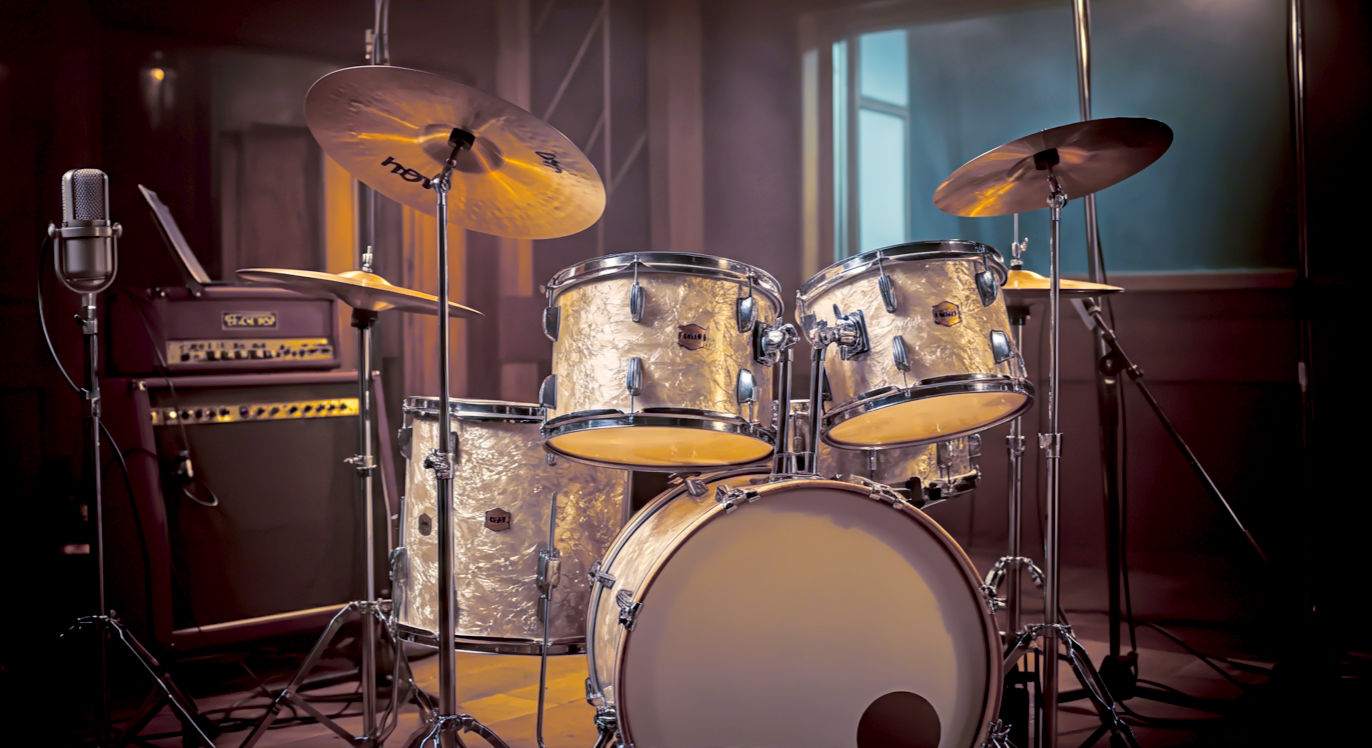Bang on: The Ultimate Guide to the Drum Kit’s History, Evolution, and Sound
Discover the ultimate guide to the drum kit. From its invention to the legendary British drummers who shaped its sound, this article covers the complete history and types of this iconic instrument.

This post may contain affiliate links. If you make a purchase through these links, we may earn a commission at no additional cost to you.
The drum kit. It’s the thumping heart of almost every band you’ve ever loved. From the quiet shuffle in a smoky jazz club to the thunderous crash that fills a stadium, it’s the engine room of modern music. But have you ever stopped to think about how this incredible instrument came to be? It wasn’t invented by one person in a flash of genius. Instead, the drum kit is a brilliant piece of problem-solving, a story of street parades, clever inventions, and musicians who just needed to make a bigger noise.
For anyone in Britain, the sound of the drum kit is woven into our cultural fabric. Think of Ringo Starr’s steady, inventive beat driving The Beatles to global stardom, Keith Moon’s chaotic energy powering The Who’s rock anthems, or the sharp, electronic pulse of 80s synth-pop bands from Sheffield and Basildon. The drum kit isn’t just a collection of drums and cymbals; it’s a time machine, a storyteller, and the backbone of the tunes that define our lives.
This guide will take you on a journey through the fascinating history of the drum kit. We’ll look at how it was pieced together, explore the different types you’ll see today, and understand why it remains one of the most powerful and exciting instruments in the world. Whether you’re a budding drummer, a music fan, or just curious, get ready to discover the story behind the beat.
What Exactly Is a Drum Kit? The Anatomy of the Beat
Before we dive into its history, let’s get to grips with the instrument itself. At its core, a drum kit—or drum set, as it’s also known—is a collection of drums, cymbals, and other percussion instruments arranged to be played by one person. It’s like a percussion orchestra for a single musician.
While kits can be customised in countless ways, a standard, five-piece acoustic kit usually includes the following key components.
The Core Drums: Shells and Skins
The main body of the kit is made up of drums, which are essentially hollow shells, usually made of wood like maple, birch, or mahogany. The type of wood affects the sound—maple is warm and balanced, while birch is brighter with a punchy attack. Each end of the shell is covered by a plastic membrane called a “drumhead” or “skin,” which is struck to produce the sound.
Here are the main players:
- The Bass Drum (or Kick Drum): This is the big one that sits on the floor. You play it with a foot pedal, and it produces the deep, low-pitched thump that often lands on the main beats of the music. It’s the foundation of the rhythm. Think of it as the heartbeat of the song.
- The Snare Drum: The snare is the star of the show. It sits on a stand between the drummer’s knees and has a set of metal wires (called snares) stretched across the bottom head. When you hit the top head, these wires vibrate against the bottom one, creating a sharp, snappy crack. It’s the sound that provides the backbeat in most pop and rock music—that classic one-TWO-three-FOUR rhythm.
- The Toms (or Tom-Toms): These are the other drums mounted on top of the bass drum or on stands. A standard kit has two: a smaller, higher-pitched one (the high tom) and a slightly larger, deeper-sounding one (the mid tom). There’s often a third, larger tom that stands on its own legs, called the floor tom, which produces an even deeper tone. Toms are used for “fills”—those exciting little runs and patterns that link different sections of a song together.
The Cymbals: The Shimmer and the Crash
Cymbals are the shiny metal discs that add colour, texture, and accents to the music. They’re usually made from an alloy of bronze and are crucial for keeping time and adding drama.
- The Hi-Hats: This is a pair of cymbals mounted on a stand with a foot pedal. When you press the pedal, the two cymbals clamp together. You can play them with sticks when they’re closed for a tight, crisp tick-tick-tick sound, or open them with the pedal for a fizzing, sustained tssssshhhh. The hi-hat is the primary timekeeper in most drumming.
- The Ride Cymbal: Usually the largest cymbal in the kit, the ride is used for playing steady rhythmic patterns, much like the hi-hat, but with a more open, shimmering sound. Hitting its edge produces a washy tone, while playing the “bell” in the centre creates a clear, piercing ping.
- The Crash Cymbal: As the name suggests, this is for making a big entrance! The crash cymbal is hit at key moments to add a powerful, explosive accent—like at the start of a chorus. Most drummers have at least one, often more, of different sizes for different sounds.
The Hardware: Holding It All Together
Finally, you have the hardware—the stands, pedals, and throne (that’s the drummer’s stool!) that hold everything in place. The bass drum pedal and hi-hat stand are the most important, as they allow the drummer to play with both feet, turning them into a true four-limbed musician. Good, sturdy hardware is essential; nobody wants their cymbals collapsing mid-solo!
A Brilliant Invention: The History of the Drum Kit
The drum kit wasn’t born overnight. Its creation was a slow, practical evolution driven by the need for fewer musicians to do more work. Before the drum kit existed, if you wanted a beat for your band or orchestra, you needed a whole percussion section—one person for the bass drum, one for the snare, and another to clash cymbals. This was fine for military bands and grand orchestras, but for smaller venues and travelling shows, it was expensive and impractical.
The Seeds of the Kit: Post-Civil War America
The story really begins in the United States after the Civil War in the 1860s. Street parade bands were hugely popular, with separate drummers for bass, snare, and cymbals. When these bands started playing indoors in theatres and music halls, space was tight. Clever drummers began experimenting. One of the first steps was “double-drumming,” where a single drummer would play both a snare drum and a bass drum, often hitting the bass drum with one stick and the snare with another. It was clumsy, but it was a start.
A key breakthrough came in the 1880s with the invention of the “overhang” bass drum pedal. This was a pedal that allowed a drummer to strike a nearby bass drum with their foot while their hands were free to play the snare. It was often a strange-looking contraption, sometimes with a swinging arm that looked a bit like a high-tech fly swatter. Early versions were clunky and slow, but the core idea was revolutionary.
The Man Who Kicked It Off: William F. Ludwig
The person who truly changed the game was William F. Ludwig. In 1909, Ludwig and his brother, Theobald, founded the Ludwig & Ludwig company in Chicago. William was a professional drummer who was frustrated with the unreliable bass drum pedals of the day. He designed and patented the first truly functional, spring-driven bass drum pedal. It was fast, responsive, and reliable, and it allowed drummers to play complex bass drum patterns with ease. This invention is arguably the single most important step in the creation of the modern drum kit. It freed up the hands to do more interesting things.
Suddenly, one drummer could do the job of three. They could play a bass drum with their foot, a snare drum with one hand, and could even rig up a small cymbal to be struck with a stick attached to the bass drum pedal—a forerunner of the hi-hat. Early drum kits were often called “trap sets,” because they included a host of other percussive “contraptions” or “traps” like woodblocks, cowbells, and whistles, used for sound effects in vaudeville shows and silent films.
The Roaring Twenties and the Birth of the Hi-Hat
The 1920s jazz age was a period of rapid innovation. Drummers needed a way to play timekeeping patterns on cymbals with their sticks, not just their feet. The first attempt was the “low-boy,” a pair of small cymbals mounted on a low stand, operated by a foot pedal. It made a “chick” sound when closed, but you couldn’t really play it with sticks.
Then came another stroke of genius: someone had the idea to raise the low-boy up on a taller stand so it could be played with both sticks and the foot. This was the birth of the hi-hat. Now, drummers could play intricate, swinging rhythms that would define the sound of jazz. The hi-hat, snare, bass drum, and a cymbal or two formed the core of the drum kit as we know it today. Drum companies like Ludwig, Gretsch, and Slingerland began selling complete, factory-made kits.
The Big Band Era and Gene Krupa, the First Drum Superstar
By the 1930s and 40s, the drum kit had taken centre stage in the Big Band era. Drummers were no longer just timekeepers in the background; they were becoming soloists and showmen. The first true drumming superstar was Gene Krupa. His wild, energetic playing with the Benny Goodman Orchestra, especially on the 1937 hit “Sing, Sing, Sing,” made the drums cool. Krupa popularised the tuneable tom-toms we see today (another Ludwig innovation) and helped standardise the classic four-piece kit: bass drum, snare, a mounted tom, and a floor tom. His theatrical solos inspired a generation of young people to pick up sticks.
The British Invasion and the Rise of the Rock Drummer
While the drum kit was born in America, it was arguably in Britain that its role in popular music was revolutionised. In the 1960s, a new breed of drummer emerged who wasn’t just playing a beat—they were defining the sound and attitude of their bands.
- Ringo Starr (The Beatles): Ringo wasn’t the flashiest drummer, but he was one of the most musical and inventive. He had a unique, left-handed style (despite playing a right-handed kit) that gave his fills a distinctive feel. More importantly, he always played for the song. His steady grooves and perfectly placed fills on tracks like “Ticket to Ride” and “Come Together” were deceptively simple but utterly brilliant. He also popularised the Ludwig brand in the UK, making it the must-have kit for aspiring drummers.
- Keith Moon (The Who): If Ringo was the master of taste, Keith Moon was the master of chaos. He played the drums like a lead instrument, a furious flurry of tom rolls, cymbal crashes, and bass drum explosions. He didn’t just keep time; he wrestled with it. Moon popularised massive drum kits with multiple toms and two bass drums, creating a wall of sound that was as much a part of The Who’s identity as Pete Townshend’s guitar chords.
- John Bonham (Led Zeppelin): For many, John Bonham is the greatest rock drummer of all time. His playing was the perfect combination of power, groove, and finesse. He had a thunderous right foot, creating a bass drum sound that was colossal, famously captured on “When the Levee Breaks.” Bonham’s grooves on songs like “Good Times Bad Times” and “Fool in the Rain” are legendary, and his powerful, heavy-hitting style defined the sound of hard rock and heavy metal for decades to come.
These British drummers, along with others like Charlie Watts of The Rolling Stones, changed how people saw the instrument. The drummer was now a rock star.
Types of Drum Kits: Acoustic vs. Electronic and Beyond
Today, drummers have more choices than ever. Drum kits generally fall into two main categories: acoustic and electronic.
The Acoustic Drum Kit: The Classic Sound
This is the traditional drum kit we’ve been talking about. It generates sound purely through vibration: you hit a drumhead, the shell resonates, and you get a rich, complex, and loud noise.
- Pros:
- Dynamic Range and Nuance: The sound responds directly to how you play. Hit it softly, and it’s quiet; hit it hard, and it’s loud. The tone changes depending on where and how you strike the drum or cymbal. This gives acoustic kits a huge expressive range.
- Feel: There’s nothing quite like the feeling of sticks rebounding off a real drumhead or the wash of a real cymbal.
- Visual Appeal: An acoustic kit looks impressive on stage.
- Cons:
- Loud: They are very, very loud. This makes them difficult to practise at home without annoying your family and neighbours.
- Space: They take up a lot of room.
- Maintenance: They need regular tuning to sound good, and drumheads and cymbals can break.
Acoustic kits come in various configurations. A four-piece kit (bass, snare, one tom, one floor tom) is classic for jazz and vintage rock. A five-piece kit (adding a second tom) is the most common standard for pop and rock. Of course, you can get much larger kits—metal and prog-rock drummers are famous for their enormous, elaborate setups.
The Electronic Drum Kit: The Quiet Revolution
Electronic drum kits, or e-kits, first became popular in the 1980s. Early models, like the iconic hexagonal Simmons kits used by bands like Duran Duran and Spandau Ballet, had a distinctly synthetic, robotic sound. But technology has come a long way since then.
An electronic kit works very differently. Instead of acoustic drums, you have rubber or mesh pads with electronic sensors inside. When you hit a pad, the sensor sends a signal to a central computer, or “brain,” which then plays a pre-recorded drum sound through headphones or an amplifier.
- Pros:
- Volume Control: This is their biggest advantage. You can plug in headphones and practise silently, anytime, day or night.
- Versatility: With the push of a button, you can change the sound of your entire kit. You can switch from a rock kit to a jazz kit, a funk kit, or even a set of steel pans or orchestral timpani.
- Recording: Most e-kits can be plugged directly into a computer, making it easy to record your playing.
- Compact: They are generally smaller and lighter than acoustic kits.
- Cons:
- Feel: While modern mesh-head pads feel much better than old rubber ones, many drummers still find the playing experience less natural than an acoustic kit.
- Nuance (Historically): Cheaper e-kits can struggle to replicate the full dynamic range and subtle variations of an acoustic drum. However, high-end models are now incredibly sophisticated and responsive.
- Sound Quality: The sound is only as good as the samples in the brain and the quality of your headphones or amplifier.
Hybrid Kits: The Best of Both Worlds?
A growing trend is the hybrid kit. This involves blending acoustic and electronic elements. For example, a drummer might use an acoustic kit but add an electronic sample pad to trigger sounds like handclaps or a deep sub-bass drum that aren’t possible on an acoustic kit. Or they might place electronic triggers on their acoustic drums to blend the natural sound with a digital sample, a common technique in modern rock and metal production to get a powerful, consistent sound.
The Drum Kit’s Enduring Impact on British Culture
From the dancehalls of the 40s to the rave tents of the 90s, the sound of the drum kit has been the pulse of British youth culture for nearly a century.
- Skiffle and the DIY Beat: In the 1950s, before rock ‘n’ roll properly hit, Britain was swept by a craze for skiffle music. Bands like Lonnie Donegan’s used makeshift instruments, including washboards and tea-chest basses. This DIY spirit inspired thousands of kids, including a young Ringo Starr, to form bands and create their own rhythm sections, paving the way for the beat boom.
- The Sound of Swinging London: In the 60s, the sharp suits and cool grooves of bands like The Kinks and The Small Faces were driven by drummers who locked into a powerful, danceable rhythm. The drum kit was the engine of Mod culture.
- Punk Rock’s Raw Energy: In the late 70s, punk rock stripped music back to its raw essentials. Drummers like Topper Headon of The Clash played with a ferocious, stripped-back intensity. The beat was fast, simple, and full of aggression—a perfect reflection of the social mood.
- The Drum Machine and Electronic Pop: The 1980s saw the rise of the drum machine, like the Roland TR-808, which threatened to make drummers obsolete. British synth-pop bands embraced these new electronic beats, creating the futuristic sound of a new decade. Yet, many bands, like The Police with the incredible Stewart Copeland, showed that a human drummer could bring an energy and creativity that no machine could match.
- Britpop and the Return of the Classic Groove: In the 90s, Britpop bands like Oasis and Blur looked back to the 60s for inspiration. Their drummers, Alan White and Dave Rowntree, provided the solid, powerful, and distinctly British grooves that got a whole new generation dancing.
Getting Started: Tips for Aspiring Drummers
Inspired to pick up the sticks? Here are a few practical tips for anyone in the UK looking to start their drumming journey.
- Start with the Basics: Before you even think about buying a kit, get a pair of sticks and a practice pad. A practice pad is a small rubber pad that lets you work on your stick control and technique (known as “rudiments”) without making much noise. This is the foundation of all good drumming.
- To Go Acoustic or Electronic?: This is the big question. If you have understanding neighbours (or a garage), an acoustic kit is a wonderful thing. But for most people starting out in a typical British semi-detached house, an electronic kit is the far more practical option. You can find excellent entry-level e-kits from brands like Roland, Alesis, and Yamaha.
- Get Lessons: You can learn a lot from YouTube, but nothing beats a real-life teacher. A good tutor will teach you proper technique from the start, helping you avoid bad habits that can be hard to unlearn later. They’ll also tailor lessons to the music you love.
- Protect Your Hearing: This is incredibly important. Acoustic drums are loud enough to cause permanent hearing damage over time. Always wear ear protection when playing. You can get specialised drummers’ earplugs that cut down the volume without muffling the sound.
- Join a Band: The real joy of drumming is making music with other people. Once you’re comfortable with some basic beats, look for other musicians to jam with. It’s the best and most fun way to improve.
The Future of the Beat
The drum kit has come a long way from its humble beginnings. So, what does the future hold? Technology continues to evolve. High-end electronic kits are becoming almost indistinguishable from acoustic ones in sound and feel. Software and sampling technology allow drummers to access a near-infinite library of sounds.
Yet, for all the technological advances, the appeal of the acoustic drum kit remains. There’s something primal and deeply human about hitting something with a stick to create a rhythm. It connects us to the most ancient forms of music-making.
The drum kit is a testament to human ingenuity—a beautiful, complex, and powerful instrument forged from a simple need to create a bigger beat. It has been the heartbeat of our favourite songs for over a hundred years, and its rhythm shows no sign of stopping. Whether it’s the raw power of an acoustic kit in a sweaty rock club or the precision of an electronic kit in a modern pop track, the drum kit will continue to be the force that moves our feet and stirs our souls.
Further Reading
For those looking to dive even deeper into the world of drumming, these resources are highly recommended:
- Modern Drummer: One of the most respected drumming magazines and websites in the world, full of interviews, lessons, and gear reviews.
- Drummerworld: An incredible online resource featuring videos and biographies of hundreds of the greatest drummers in history.
- The Ludwig Drums Website: Explore the history of the company that was so pivotal in the drum kit’s development.






